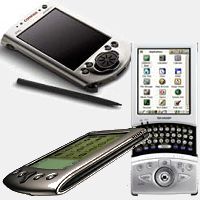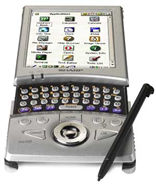

|
Linux on the move: Sharp Zaurus SL-5500 and other Linux PDAsPrinted version: Algorithmica Japonica, June 2002Last revision: 16 February 2004Ulrich Plate |
Pay-off time! Over the past four years or so, geeks all over the planet have been tweaking their palm-sized devices, trying to replace the built-in operating system with the open source OS and applications of their dream. Lovingly hand-knitted Linux and NetBSD kernels for the tiniest of machines have emerged; Palm-sized iPaqs, Cassiopeias, Palmpilots, and handheld PCs with keyboards like NEC’s Mobile Gear or HP Jornada are known to accept alternative Unix-like operating systems now, and even the ones with less than 8 MB RAM stand a chance of at least sporting a little stand-alone shell. To achieve this has certainly not been an easy task: we’re talking a variety of CPUs and hardware architectures here, and only lukewarm support from PDA manufacturers at best--nobody’s happy when you clearly state their platform sucks and you want to get rid of it at the first occasion. But over time, dozens of developers out in the romantic wild successfully managed to squeeze Linux into all their favourite gadgets, and now it’s finally going peek-a-boo out of the woods and into the realm of normal users.
Because the days when you needed to have all this geeky expertise are over! While credit for the first PDA shipped with native Linux must certainly go to other manufacturers, it is Osaka-based Sharp Ltd. with their global marketing aplomb who have decided to challenge the incumbent players like HP/Compaq and Sony with an off-the-shelf open source PDA: Linux takes WinCE and Palm OS to battle for the consumer market, and the first skirmishes look as if it’s actually doing not bad at all.
 Sharp has started shipping the SL-5500, its second Linux-based model after a quietly introduced developer model (SL-5000D) back in October. Available in the US and in Germany since April, with the UK and Canada to follow soon, it’s slowly creeping into the worldwide PDA market, which contrary to what many analysts say isn’t shrinking at all, just not growing as fast as before, but expected to pick up speed again soon enough. Japan, unfortunately, is excluded from the SL-5500’s “limited regional launch”, possibly to protect the large market share Sharp still holds with their traditional non-Linux Zaurus models in Japan.
Sharp has started shipping the SL-5500, its second Linux-based model after a quietly introduced developer model (SL-5000D) back in October. Available in the US and in Germany since April, with the UK and Canada to follow soon, it’s slowly creeping into the worldwide PDA market, which contrary to what many analysts say isn’t shrinking at all, just not growing as fast as before, but expected to pick up speed again soon enough. Japan, unfortunately, is excluded from the SL-5500’s “limited regional launch”, possibly to protect the large market share Sharp still holds with their traditional non-Linux Zaurus models in Japan.
The SL-5500 had the computer press and prospective users in Japan confused for a while, because it looks exactly like the Japanese eZaurus series, with its slide-out keyboard, CF and SD slots, headphone jack, and the 240x320 dot 16 bit colour screen, and you have to look very closely to see any differences at all. But inside it is clearly different: Gone is the traditional Hitachi SH3 processor, replaced by the Intel StrongARM SA-1100 (the same as in iPaq and many other PocketPCs), and the memory is twice that of the newest Japanese models: 64 MB.
The operating system is from Lineo, who - having burnt through too high a stack of cash - unfortunately got auctioned off to its own VCs last month and is rumoured to be chopped to pieces and fed to the beasts now. But their Linux flavour called Embedix is less likely to disappear, in the wake of the expected success of the Zaurus, and follow-up projects are already emerging: An Indian company, Infomart, has decided to pretty much do as Sharp does, except on slightly scaled-down hardware. Ironically, the Infomart Kaii (significantly cheaper than the SL-5500) is based on the same Hitachi SH3 processor as the Japanese Zauri, but uses the Embedix OS and the Trolltech Qtopia desktop of the international Zaurus.
Aside from all the fuzz about open source and consequently PDAs with Linux being dear to people habitually sitting amidst pizza cartons and hacking away at obscure programme code, Linux PDAs do pretty much the same thing as an iPaq or Palm. Qtopia, for example, includes a PIM suite of calendar, address book and other utilities more or less like the ones you’d find in any other PDA, and of course the Zaurus syncs with your Windows PC. In terms of direct benefits, the fact that it’s Linux underneath frankly doesn’t play much of a role to mainstream PDA users. But there are some hidden assets: Because it’s open source, it’s much more prone to greatly motivate new software development by programmers everywhere. And even at this early stage some things are already rather smart. “Synchronising”, for example, is done via TCP/IP, meaning you may still use the cradle that connects to your PC via USB, but the Zaurus really couldn’t care less if you choose not to, it’s just as happy to connect via a wireless or wired Ethernet LAN card. It also means that Macintosh users don’t need to worry about the missing sync software for MacOS--all the Qt PIM data is in XML, and you may trust the community to come up with a parser to make it fit into Macintosh applications any moment now.
It really is Linux, after all: You can ftp to your Zaurus, you can telnet, browse the web from it, you can even run an entire web site from your Zaurus if that’s what you want to do. There’s tons of software already available (clever: Qtopia-developer Trolltech organised a software contest before the launch of the consumer model), and before the year is over you can expect virtually every Linux application that runs on a desktop to be ported to the Zaurus. At 206 MHz CPU speed and 64 MB memory there are some limitations, of course, but that’s still more powerful than most desktop PCs were only a few years back.
Looking at the competition, there are only a handful (sic) of other Linux PDAs in the market right now: The Korean G.Mate YOPY (www.yopy.com) with its unique clam-shell form factor, home-grown Linupy operating system and ABCDE keyboard can be bought online for US$399 (both Korean and English versions). Agenda Computing could arguably have been called the first company to sell a native Linux PDA, but alas: they went out of business a few months ago. Fortunately, production and distribution of the Agenda VR3 has been taken over by Softfield Technologies (www.softfield.com) of Hong Kong, and their tiny MIPS-based device with native Linux is now sold exclusively via the Internet for US$105 (8 MB RAM model) or US$135 (16 MB). Last but not least, a Palm Vx look-alike Linux PDA, Empower Technologies’ “Powerplay V” is priced at US$149 (www.linuxda.com).
Other than iPaqs with pre-installed Linux being sold by some vendors (see below), that’s about it for the moment, but many more native Linux PDAs have already been announced for launch sometime this year, like the “Royal Lin@x” (www.royal.com, expected to sell for US$299), and two more Korean manufacturers, HNT (www.hntek.co.kr, “Exilien” series) and Hangil are expected to start shipping shortly, too, as well as Taiwanese Master IA and Micat, and the Indian Infomart Kaii mentioned earlier is also due anytime now. Plenty of choice.
But if your old PDA is still doing nicely, and you just want to give feeding it Linux a try, there’s even more to choose from. The various distributions available for the iPaq seem to be the most mature implementations. It certainly is a disadvantage for the mass market that you need to install Linux yourself, but the iPaq makes up for that with an ample choice of flavours: first of all, there’s Familiar, represented at familiar.handhelds.org, and its escalation, Intimate, at intimate.handhelds.org. Both have received some backing by Compaq, being hosted at a website sponsored by the iPaq manufacturer. Then there are several other distributions, some of them commercial: mLinux by the same German company that was chosen as Sharp’s support centre for the German Zaurus (www.lisa.de) forUS$35 (available also pre-installed on iPaq 3660 or 3760); Pixil by Century Embedded Technologies (free download at www.censoft.com); PocketLinux--in a state of arrested development--is downloadable from www.pocketlinux.com; Trolltech’s (www.trolltech.com) Qt/embedded has been available for some time, and RedHat has a package for iPaqs, too (www.redhat.com/embedded).
In Japan, two companies, Axe Inc. and a corporation with the intriguing name 10art-ni (try spelling it backwards, that’s apparently what they do for a living) provide a Japanese Linux and GUI suite. Axe, by the way, supplied Sharp with the XTAL real-time OS that runs at the core of the Japanese Zaurus models, and they also keep a repository of zxLinux, a stand-alone shell for Japanese Zauri running on top of XTAL that doesn’t actually do much, but never fails to impress people when they see it run on a battered two-year-old organiser with very low memory, and comes with a software development kit so you could actually roll your own application suite (www.zxlinux.com, www.zxlinux.org). Axe’s more fully developed axLinux and the GUI desktop suite Sikigami complete with handwritten Kanji recognition for iPaq and NEC Mobile Gear II, at www.sikigami.com, can be downloaded for free. If you need support, 10art-ni’s Melon (melon.10art-ni.co.jp) at ¥9800 is a repackaged Familiar Linux plus Sikigami GUI, and is sold on a compact flash card or, conveniently enough, pre-installed on iPaq 3630.
The wealth of choice is less impressive for Palm and its clones, but it’s there nonetheless. The Palm’s major problem lies in its lack of a Memory Management Unit for Motorola’s Dragonball processor, meaning it’s much slower, and the Linux kernel must be heavily modified to run at all. Compared to the iPaq Linux distributions, let alone the Zaurus, it may be a little disappointing, but it has its fan community all the same. LinuxDA for Palm III and V is available from Empower Technologies (see above) for US$60, and Micro-Controller Linux (μClinux, at www.uclinux.org) for US$128 (that’s for the official CD, but you can still download it for free).
Fascinating stuff. Everybody admits that there needs a lot to be done before people who don’t write code for a living can really benefit from the full wealth of applications in the foreseeable future. Recent studies seriously suggest that Linux will emerge as a dominant market force, with 47 percent of all embedded platforms expected to run Linux by 2005 (counting wrist watches and smartphones, too, not just PDAs), at an estimated turnover of over US$300 million, up from 28 million last year (source: VDC). Let’s hope some of that money will get re-invested in manuals for the rest of us.